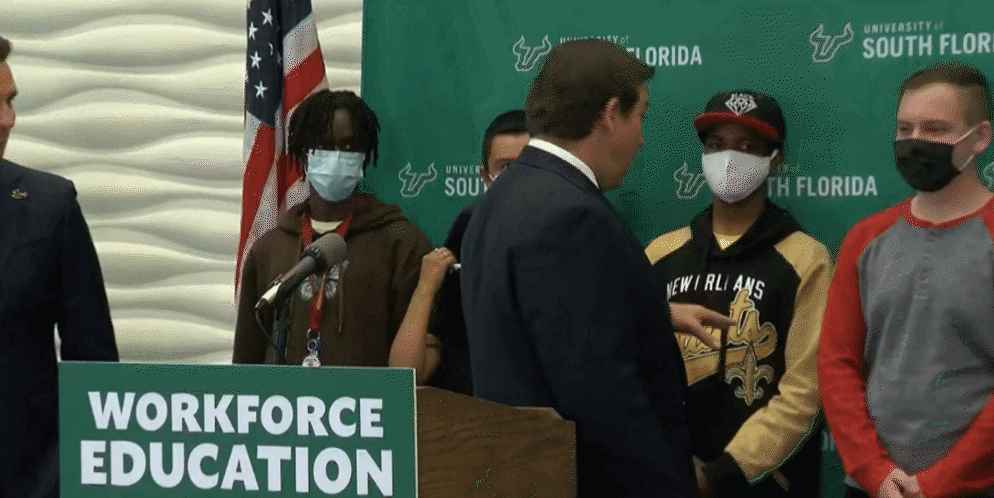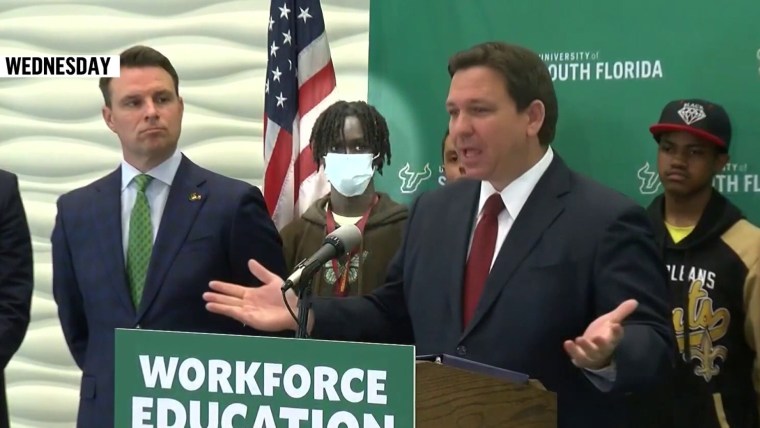Florida Gov. Ron DeSantis chastised a group of high school students for wearing masks in his presence, saying “Please, take them off. Honestly, it’s not doing anything and we’ve got to stop with this Covid theater. So if you want to wear it, fine, but this is ridiculous.” The governor later doubled down on this message, with his press secretary stating after the event, “There’s no evidence masks make any difference.”
Kids might choose to wear masks for a variety of reasons. Some have already experienced losses from the pandemic and are more vigilant as a result.
He is wrong about the science — masks work, and better masks work better — and he is profoundly wrong about how we should treat kids who continue to wear masks to keep themselves, their families and their communities safe.
Although we are in a far better place than earlier this year, with Covid-19 cases across the U.S. down more than tenfold from the peak in January, the pandemic is not over. During the week prior to DeSantis’ outburst, more than 10,000 people in the U.S. died of Covid. While case numbers are lower and give us the opportunity to pull back on some public health protections, we are still seeing hundreds of thousands of new cases every week, and it is not yet clear what the future will hold.So, we need to ask: Who needs to continue to wear masks in schools, especially given reduced protection if those around them are no longer wearing masks, and who would be harmed if they were bullied or coerced into taking off their masks?
We can start by thinking about children who are at elevated risk from Covid. Studies have shown multiple risk factors for more severe outcomes, including diabetes and obesity. Vaccination greatly reduces these severe outcomes, but only 26 percent of those ages 5-11 have been fully vaccinated. While it is true that a much smaller percentage of children than older adults die from the virus, more than 1,500 children have died from Covid, and many others suffer from long Covid.
We can also widen the lens and recognize that children live and interact with many other people, who could include siblings under 5 who are currently ineligible to be vaccinated or adults who are immunocompromised or are otherwise at high risk. So, it would be important for low-risk children to wear masks to reduce the risk of passing Covid to high-risk people around them.
Other kids might choose to wear masks for a variety of reasons. Some have already experienced losses from the pandemic and are more vigilant as a result. Others may use masks because they have high-risk friends and want to help them both be better protected and feel like they are not alone.
Fundamentally, you cannot tell from looking at a child whether or not it is important for that child to use masks — kids don’t carry around signs that tell everyone about, for example, their chronic health conditions, their mother’s ongoing chemotherapy for breast cancer or about the fact that their grandfather lives with them and has chronic obstructive pulmonary disease.
Importantly, these burdens and risk factors are not equally shared. Throughout the pandemic, as different variants hit different parts of the country before and after access to vaccines, there has been one constant – a disproportionate burden on people of color. For example, of the children for whom we have race/ ethnicity data, approximately 56 percent who have died from Covid and 58 percent who have suffered from multisystem inflammatory syndrome have been Hispanic or non-Hispanic Black children.
In addition, Black and Hispanic people make up 46 percent of the Covid deaths with race/ethnicity data of those ages 18-64 — even though together they comprise approximately 32 percent of the U.S. population in this age group. This includes many parents of school-aged kids. Asian Americans have also been hard hit by the pandemic, both in terms of the disease itself and an increase in racist attacks.
Numerous factors contribute to these disparities, including underlying medical conditions, health care access, exposures at work, the ability to isolate at home and reduce the risk of transmission within households and other manifestations of structural racism. There are also racial/ethnic disparities in vaccination status. Fifty-four percent of white non-Hispanic people have received a booster dose once they became eligible, compared to about 44 percent of Black non-Hispanic people and nearly 40 percent of Hispanic people. There are minimal data available on racial/ethnic patterns of vaccinations in kids. Still, given very low uptake among younger kids and evidence of large geographic disparities in some states, it is likely that there are disparities in vaccinations for kids, as well.
In an era of optional mask use in schools, kids who need to wear them are more likely to be lower-income, people of color and those grappling with chronic health conditions. These kids are already more likely to be marginalized and targets of bullying. We can support, accept and protect those who are wearing masks for various reasons, or we can attack, denigrate and bully those who may already be going through difficult times.
Some might say it is overly dramatic to say that DeSantis was bullying the kids wearing masks. But I think it is the perfect description — it was a person in a position of power trying to coerce people with less power. Leaders, parents and teachers need to show our kids that there are better ways to treat one another. In preparation for the move to optional mask use, my son’s second grade teacher conveyed this simple but powerful message to the kids: “Some students and teachers will choose to keep wearing a mask. Other students and teachers will choose to stop wearing a mask … We must respect each family’s mask choice.”
At its heart, this is about two universal messages that so many of us try to convey to our kids — treat others as you would like to be treated, and try to put yourself in someone else’s shoes before you make judgments about them. DeSantis clearly needs some remedial education to understand that this is real life, not theater, and that vulnerable kids and their families are not disposable props.
Source: | This article originally belongs to Nbcnews.com











